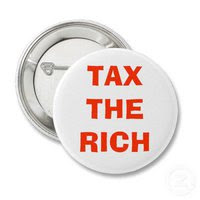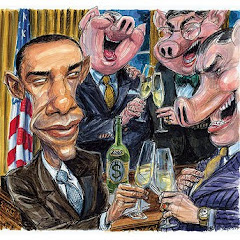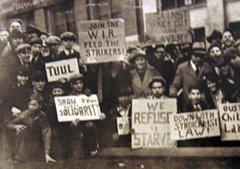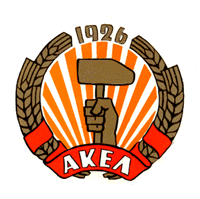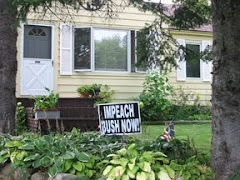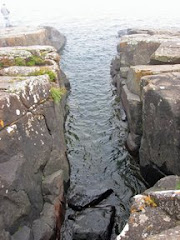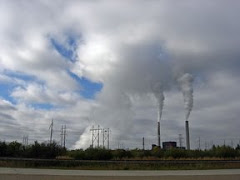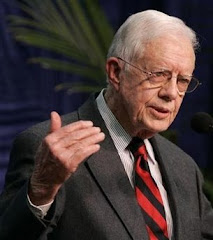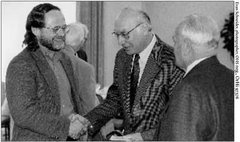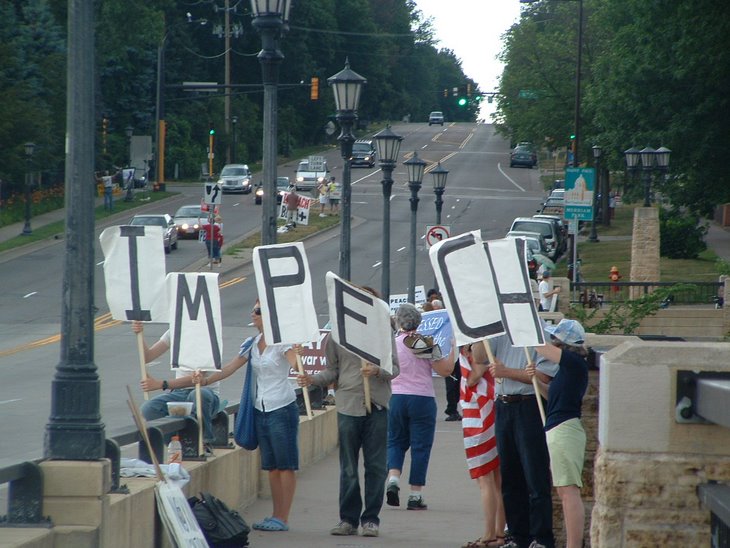Sunday, April 12, 2009
Barack Obama sees "glimmers of hope"
Today, Barack Obama sees, "glimmers of hope."
Does anyone other than Obama see these "glimmers of hope?"
But, where's the change?
Barack Obama says the housing market is key to economic recovery.
Others say different.
I don't know what they are growing in that White House garden, but Obama must be puffing on something other than ordinary tobacco because he also said today that "home losses" were a big part of the "hardships" Americans are being forced to endure while the media is telling us one out of every nine homes in this country is not occupied and he is doing nothing to stop the foreclosures and evictions when a moratorium for the duration of this depression would be so easy--- especially if he is seeing "glimmers of hope."
These two articles tend to tell us Barack Obama is wrong and hallucinating when he says he sees, "glimmers of hope" and that "the housing market is key to economic recovery."
We really do need to take some time to study this situation because if the President of the United States and his economic advisers don't know what is required for "economic recovery" any more than his military advisers understand what constitutes peace we are in some real deep doo-doo.
Quite frankly, I think we have some way over-paid economists being led around by a President who hides behind the skirt of Rosy Scenario and this definitely does not bode well for us working people.
If the auto and steel industries don't work, the housing problem sure can't be fixed.
What is interesting is that China has become the world's largest steel AND auto producer.
Anyone care to figure out how all of this fits together in a world faced with a global capitalist economic melt-down?
Check out these articles; one from Canada and China, the other from France:
Global steel industry awaits auto turnaround
http://news.yahoo.com/s/afp/20090412/bs_wl_afp/commoditiesmetalssteelsector
PARIS (AFP) – Steel is on edge and the global industry is cutting back hard, hanging on for either a budget blast from China, new credit for vast Middle Eastern building schemes or resurrection of the US auto industry.
Demand has dwindled and steelmakers, notably the giant of them all, ArcelorMittal, are damping down surplus furnace capacity while waiting for credit to flow, construction cranes to turn and factories to roll.
A decision by ArcelorMittal last week to pursue temporary production cutbacks, slashing European output by more than half from the end of April according to a union source, dramatises the extraordinary ride and role of steel in the last few years.
In just months the global industry has gone from a boom driven largely by China, emerging markets and a property extravaganza in the Middle East to a narrow line between excess capacity and the costs of waiting for recovery.
"Over the past six months, demand for steel has dropped dramatically and, as a result, producers have been cutting production," analysts at Barclays Capital said in a study last week.
In another report, Morgan Stanley predicted "the current demand shock to lead to excess steel capacity."
Consequently, the bank said, steel plants should operate at rates below 75 percent of capacity until 2012.
"The steel market is not very different from base metals as a whole, but steel has reacted more rapidly and dramatically since September," said commodities analyst Perrine Faye of London-based FastMarkets.
She said the future of the steel industry depended on three factors -- the impact of Chinese economic stimulus efforts, a pick-up in the Middle East construction sector and a revival of the once mighty US auto industry.
"Chinese imports and exports are at a standstill. Everyone is waiting for the Chinese stimulus package to see if it will revive demand."
The Chinese government last month announced a four-trillion-yuan (580-billion-dollar) package of measures that it said could contribute 1.5 to 1.9 percent to the country's economic growth.
Industry experts have meanwhile spoken optimistically of China's prospects.
Thomas Albanese, chief executive at steel maker Rio Tinto, said earlier this year that the company foresaw "a short, sharp slowdown in China, with demand rebounding over the course of 2009, as the fundamentals of Chinese economic growth remain sound."
Analysts have said steel inventories are falling in China in anticipation of projects expected to emerge from the country's huge stimulus package.
"It is encouraging that the inventory of steel products, especially long products, which are mostly used in construction projects, have started to fall (since the end of March), likely suggesting that end-demand is gathering momentum," Frank Gong, a Hong Kong-based economist for JPMorgan, wrote in a research note.
On-the-ground evidence suggested that the Chinese industry had been re-stocking in the first two months of the year, followed by a pause in March before major infrastructure projects were expected to start in the second quarter, Gong wrote.
In the Middle East, according to Faye, the big problem is a shortage of credit, notably for real estate developers and builders.
Construction planners had "counted on a higher price for oil and on credit to finance their huge projects."
In addition, demand for such facilities, especially in the Gulf, has died.
"They were hoping that Americans and Europeans would buy apartments. But property prices have collapsed in the Middle East as well."
In the United Arab Emirates more than half the building projects, worth 582 billion dollars or 45 per cent of the total value of the construction sector, have been put on hold, a study by Dubai-based market research group Proleads found in February.
In Dubai, one of the states of the UAE, prices in the real estate sector have slumped by an average of 25 percent from their peak in September after rallying 79 percent in the 18 months to July 2008, according to Morgan Stanley.
Faye said the fate of the steel sector was in addition tied to that of the struggling US auto industry, once a thriving steel market but one in which two of its giant players, General Motors and Chrysler, are staring at bankruptcy.
The two companies are currently limping along thanks to billions of dollars in government aid.
"We are waiting to see if the auto sector in the US will get out of the crisis intact," she said.
http://www.theglobeandmail.com/servlet/story/RTGAM.20090411.wrcover11/BNStory/Business
China's runaway steel train
April 11, 2009 at 12:47 AM EDT
FENGRUN, CHINA and TORONTO — Yu Jianshui fidgets in his big leather chair
as he chain-smokes his way through an interview. Times are tough at the
Tangshan Fengrun Zhengda Iron and Steel Co. Ltd.
With China suffering its sharpest economic slowdown in decades, Mr. Yu, the
firm's general manager, complains that he is getting fewer and fewer orders
for his main product, huge bars of raw steel known as billets. In his 23
years in steel, “this is the worst I've ever seen.”
Yet under the corrugated metal roofs of his steel mill, blast furnaces
still blast and two assembly lines still roll out 3,000 tonnes of steel a
day.
It is the same story elsewhere in Fengrun, a gritty steel town where the
red flag of the People's Republic flies from giant-like loading derricks.
After shutting briefly when steel prices dipped last fall, most of
Fengrun's more than 100 mills have come back to life to exploit a price
uptick this winter, churning out countless tonnes of pipe, girders, rolled
steel and heavy cable.
And that, Mr. Yu says, is the problem: Not that so many mills are going out
of business, but that so many are still going.
China simply makes too much steel. The government estimates that China's
annual production is about 100 million tonnes more than it should be, a
figure equal to the whole annual output of the industry in the United
States.
Worse, China has far too many steel companies, more than 700 at last count.
Add in iron companies and companies that roll or otherwise shape steel, and
the total comes to more than 7,000. Despite repeated government attempts to
force them to consolidate into fewer, bigger companies, most of them are
still small and inefficient.
By rights, many companies should have closed. Instead, they march on like
zombies, China's industrial undead.
That was not such a problem when China was growing at 10 per cent or more a
year and demand was soaring for products made in the “workshop of the
world.” No matter how much steel China made and how many companies were
making it, there was always a market somewhere.
Now it's a problem, and not just for China and its steel makers. In China
and around the world, demand for steel is plummeting. Producers are cutting
back: Japan's output fell 39 per cent and Germany's 31 per cent in February
from the same month last year.
But China's crude steel production in February actually grew 4.9 per cent,
even as steel exports hit a 52-month low, falling 62 per cent on a yearly
basis. Since last October, most steel makers have been losing money. Prices
for Chinese hot-rolled steel fell to about $400 (U.S.) a tonne in March,
less than half the peak of $980 a tonne hit last year. Even China's Iron
and Steel Association has cautioned that overproduction has risked flooding
the market with unwanted steel.
In its latest master plan for steel, drawn up this winter, Beijing says it
will force the industry to slim down and consolidate. But such edicts have
been issued many times before, and instead, production has continued to
proliferate. Few believe this time is likely to be different.
The impact of China's overproduction is being felt around the world. As
demand for steel products plunges, China's continued strong production is
hurting producers in other countries. Just this week, a group of American
makers of steel pipe used in oil drilling filed complaints with U.S. trade
officials alleging unfair competition from Chinese imports they say have
been dumped on the domestic market.
“That is the challenge of China,” says Michael Willemse, an analyst
with CIBC World Markets in Toronto. “They can be very disruptive to the
global market if their capacity-expansion plans are not consistent with
consumption needs of the industrial economy.”
MINERS STILL HAPPYChina's romance with steel goes back a long way. Chinese
in the Han Dynasty, 1,800 years ago, produced an early form of steel by
combining wrought iron and cast iron.
In the disastrous Great Leap Forward of 1958 to 1961, Mao Zedong made grain
and steel production the centrepiece of his plan to surpass the decadent
West. The Great Helmsman encouraged the people to build backyard steel
furnaces in every commune and neighbourhood. To meet wildly unrealistic
production goals, they melted down pots and pans and burned furniture for
fuel.
When Deng Xiaoping abandoned Maoist economics in 1978, China began building
its steel industry in earnest. As foreign investment poured in and the
economy took off, China ramped up production. In the present decade, it has
grown at an average of more than 20 per cent a year. It now exceeds the
combined production of Japan, the United States, Russia, India, South
Korea, Germany, Ukraine and Brazil.
China became the world's biggest consumer and producer of steel, accounting
for a third of the world's total output.
Like the auto industry in North America, steel in China came to be
considered an essential industry, too big to fail. It directly employs 3.58
million people. Millions more live off it in support roles. As of 2007, it
contributed 4 per cent of China's gross domestic product and 9 per cent of
industrial profits.
For a long time, everyone seemed to benefit. Chinese steel makers were
growing and making money. Foreign steel makers were selling lots of steel
to China, which was a net importer of steel until 2006. Iron ore producers
in resource-rich countries such as Canada made a fortune as the steel boom
pushed up prices for ore.
Indeed, the relatively stable demand from China has helped coking coal and
iron prices weather the global economic collapse better than most
commodities – and if Chinese steel makers remain at their current
production levels, that would not be unwelcome to the international iron
ore and coking coal producers.
At a time when financing for most mining firms has all but disappeared,
China has been a lone source of capital, playing sugar daddy abroad to
shore up the future of the domestic steel industry. Last week, Wuhan Iron
and Steel Group Corp., or WISCO, one of China's largest steel producers,
agreed to invest a total of $240-million to acquire a 20-per-cent stake in
Consolidated Thompson Iron Mines Ltd. and a 25-per-cent stake in the
company's Bloom Lake iron ore development project in Quebec.
But for China, the continuing steel push, once a sign of strength, has
become a sign of weakness.
The sector's prodigious growth made it a vivid symbol of China's rise. Now,
it tells the story of chronic overinvestment and overcapacity, manipulated
lending, political interference in markets and overreliance on heavy
industry – faults that are being exposed by the crisis across many of the
country's industries, and that could cost China dearly as the global
recession grinds on.
Steel is not the only industry plagued by too much capacity and too many
companies. China has 5,000 cement makers, 3,800 glass makers, 3,500 pulp
and paper producers, and no less than 24,000 chemical companies.
“It's a kind of a perpetual theme here,” says Jack Perkowski, now a
merchant banker in Beijing who came to China from the United States almost
20 years ago to start a car parts company – and was startled to find
there were already 150 companies making piston rings.
“If you look at any product, there are usually only half a dozen or so
companies making it in most countries. In China, there are hundreds or
thousands making that same product.”
The reasons behind China's capacity issue say a lot about how China works
– or doesn't – and points to a slew of other problems.
Outsiders tend to think of China as a centralized state with an
all-powerful government that can order industries around at will. In fact,
real power often lies with provincial and local officials, the powerful
barons of the Chinese political system.
Like Canadian premiers, they fight among themselves to attract industry.
And steel is a particular favourite, a “pillar industry” that produces
a crucial raw material for many other prestige industries, like automobiles
and appliances. In China, Mr. Perkowski says, “every town and every
village has to have a steel mill.”
The result is a highly dispersed, even balkanized industry, with production
spread around a half-dozen major steel-producing provinces and a dozen or
more smaller rivals. Those provinces compete constantly to outdo each other
at steel production.
The perennial winner is Hebei province, a traditional industrial powerhouse
in northeastern China, surrounding Beijing and the port of Tianjin.
According to the industry watcher mysteel.net, Hebei – where Mr. Yu's
Fengrun mill is located – won the output “championship” for the
seventh successive year in 2008, producing more than 100 million tonnes.
A value-added tax introduced in 1996 gives the provincial barons even more
incentive to lure steel companies and win bragging rights. A quarter of the
revenue from the VAT goes to local governments.
Balkanization makes for massive inefficiency. In a country like China that
lacks high-grade iron ore, the ideal would be to produce steel in big,
modern plants near coastal ports, making it cheaper to bring in ore and
coking coal, and easier to export production. Instead Chinese mills often
have to bring in their ore over hundreds of kilometres of rail track,
pushing up their costs.
Pushing up pollution, too. A report last month from the Alliance for
American Manufacturing claimed that China's steel industry, with its
massive consumption of coal and electricity, produced half of the carbon
dioxide from world steel production, making it a huge contributor to the
greenhouse gases said to cause global warning. It also claimed that
governments help the industry with more than $15-billion a year in energy
subsidies, adding to pollution and overproduction.
China's government-directed banking system plays a part in runaway steel
output, too. In China, the big banks are run by the state. Their local
branches are often closely tied to local officials.
Eager to reap the taxes they get from steel companies, those officials
arrange with banks to provide financing for new mills. In China, where
labour and land is cheap, mills can be built in a fraction of the time it
takes in the West for a fraction of the cost.
If steel prices are rising, they quickly generate handsome profits. But
that adds to China's capacity and, in time, overcapacity. That, in turn,
puts downward pressure on prices. In a normally functioning market, Mr.
Perkowski says, that would lead to an industry shakeout. Weaker, smaller
mills would close. Production would fall to meet demand.
Not in China. With “everyone incentivized to keep producing,” he writes
in his 2008 book Managing the Dragon, “this capacity never closes.
Instead, the plant churns out product at ever-diminishing prices. As long
as it can sell at a price equal to the variable costs of production, it
keeps producing.” Even if it can't cover those costs, friendly banks may
step in to cover its losses.
“This is a topsy-turvy, helter-skelter model of economic growth where
each province has its own plans and the central government just sits on top
and screams,” says Hans Mueller, an independent consultant based in
Tennessee who follows China's steel industry.
The screaming does not seem to do much good. Beijing's latest master plan
would hold crude steel output to its current level of about 500 million
tonnes. It would move more steel-making capacity to the coastal regions.
And it would raise the minimum size of blast furnaces to 400 cubic metres,
up from 300 at present, with the intention of forcing smaller,
less-efficient mills to close.
The aim is to make its industry more like other countries', with a few big
dominant players. China's top three companies account for only about a
fifth of the country's total production, compared with well over half for
the top three in the United States, Russia or South Korea. South Korea, in
fact, gets 87 per cent of its production from just two giant mills.
To bang heads together, China's cabinet set a goal last month of raising
the share of output from its top five steel companies to 45 per cent of the
total from 28 per cent at present.
Canada's Teck Cominco Ltd., a major producer of coking coal used to make
steel, is betting on the consolidation of the Chinese steel industry.
Although it doesn't sell coal to China now, it hopes to in the future once
more Chinese production moves to the coast, creating demand for seaborne
coal.
Selling to China's coastal regions was a key driver behind the company's
$14-billion (Canadian) takeover last year of Fording Canadian Coal Trust
– a deal that has left Teck straining under more than $9-billion (U.S.)
in debt. “It's one of the reasons that we believe in the coal assets,”
said Teck spokesman Greg Waller. “There is going to be a fundamental
change in the valuation of metallurgical coal in the future.”
If history is any guide, it could take a long time for Teck's coal to get
to China's coast. The Chinese “have been talking about this as a matter
of national state policy since 2001 and the number of steel firms went up
and up and up,” says Daniel Rosen, principal of Rhodium Group, a New York
consultancy. “The reality went in a totally different direction.”
In fact, Beijing's massive four-trillion-yuan economic stimulus program
threatens to worsen steel's obesity issue. Much of the money will be used
for steel-gobbling projects like railway expansion. To further cushion the
industry from the global recession, Beijing is raising a rebate on steel
exports.
Yet despite the likelihood of continued Chinese steel overproduction, the
country's growth could very well serve as the cornerstone for a global
economic recovery.
Na Liu, China strategist at Scotia Capital, says China's iron and copper
imports hit record highs in February, and net imports of aluminum and zinc
are at their highest in several years. China's recent willingness to pay
$140 a tonne for coking coal helped support a 2009 benchmark coal contract
of $129 a tonne that was much higher than many expected.
As for steel, low prices coupled with China's relatively high cost of
production may have already tipped the trade balance in favour of imports.
Russian steel producers “have been selling into the Chinese market at
very competitive prices, and China might actually have become a net
importer of steel in March,” Mr. Liu says.
While China's labour and regulatory costs give it a major advantage over
other steel-producing nations, the bulk of those benefits will eventually
disappear.
“Gradually, Chinese steel mills are going to lose their cost advantages,
as environmental protection and other regulatory costs begin to go
higher,” Mr. Liu says.
Back in Fengrun, Mr. Yu knows his industry may need to change.
“When I was a kid, the country's power was measured by how much steel it
produced,” he says.
Now, he complains that the industry has too much capacity and too many
players. “They can't all survive,” he says. “Some of these companies
have to die off.”
Does anyone other than Obama see these "glimmers of hope?"
But, where's the change?
Barack Obama says the housing market is key to economic recovery.
Others say different.
I don't know what they are growing in that White House garden, but Obama must be puffing on something other than ordinary tobacco because he also said today that "home losses" were a big part of the "hardships" Americans are being forced to endure while the media is telling us one out of every nine homes in this country is not occupied and he is doing nothing to stop the foreclosures and evictions when a moratorium for the duration of this depression would be so easy--- especially if he is seeing "glimmers of hope."
These two articles tend to tell us Barack Obama is wrong and hallucinating when he says he sees, "glimmers of hope" and that "the housing market is key to economic recovery."
We really do need to take some time to study this situation because if the President of the United States and his economic advisers don't know what is required for "economic recovery" any more than his military advisers understand what constitutes peace we are in some real deep doo-doo.
Quite frankly, I think we have some way over-paid economists being led around by a President who hides behind the skirt of Rosy Scenario and this definitely does not bode well for us working people.
If the auto and steel industries don't work, the housing problem sure can't be fixed.
What is interesting is that China has become the world's largest steel AND auto producer.
Anyone care to figure out how all of this fits together in a world faced with a global capitalist economic melt-down?
Check out these articles; one from Canada and China, the other from France:
Global steel industry awaits auto turnaround
http://news.yahoo.com/s/afp/20090412/bs_wl_afp/commoditiesmetalssteelsector
PARIS (AFP) – Steel is on edge and the global industry is cutting back hard, hanging on for either a budget blast from China, new credit for vast Middle Eastern building schemes or resurrection of the US auto industry.
Demand has dwindled and steelmakers, notably the giant of them all, ArcelorMittal, are damping down surplus furnace capacity while waiting for credit to flow, construction cranes to turn and factories to roll.
A decision by ArcelorMittal last week to pursue temporary production cutbacks, slashing European output by more than half from the end of April according to a union source, dramatises the extraordinary ride and role of steel in the last few years.
In just months the global industry has gone from a boom driven largely by China, emerging markets and a property extravaganza in the Middle East to a narrow line between excess capacity and the costs of waiting for recovery.
"Over the past six months, demand for steel has dropped dramatically and, as a result, producers have been cutting production," analysts at Barclays Capital said in a study last week.
In another report, Morgan Stanley predicted "the current demand shock to lead to excess steel capacity."
Consequently, the bank said, steel plants should operate at rates below 75 percent of capacity until 2012.
"The steel market is not very different from base metals as a whole, but steel has reacted more rapidly and dramatically since September," said commodities analyst Perrine Faye of London-based FastMarkets.
She said the future of the steel industry depended on three factors -- the impact of Chinese economic stimulus efforts, a pick-up in the Middle East construction sector and a revival of the once mighty US auto industry.
"Chinese imports and exports are at a standstill. Everyone is waiting for the Chinese stimulus package to see if it will revive demand."
The Chinese government last month announced a four-trillion-yuan (580-billion-dollar) package of measures that it said could contribute 1.5 to 1.9 percent to the country's economic growth.
Industry experts have meanwhile spoken optimistically of China's prospects.
Thomas Albanese, chief executive at steel maker Rio Tinto, said earlier this year that the company foresaw "a short, sharp slowdown in China, with demand rebounding over the course of 2009, as the fundamentals of Chinese economic growth remain sound."
Analysts have said steel inventories are falling in China in anticipation of projects expected to emerge from the country's huge stimulus package.
"It is encouraging that the inventory of steel products, especially long products, which are mostly used in construction projects, have started to fall (since the end of March), likely suggesting that end-demand is gathering momentum," Frank Gong, a Hong Kong-based economist for JPMorgan, wrote in a research note.
On-the-ground evidence suggested that the Chinese industry had been re-stocking in the first two months of the year, followed by a pause in March before major infrastructure projects were expected to start in the second quarter, Gong wrote.
In the Middle East, according to Faye, the big problem is a shortage of credit, notably for real estate developers and builders.
Construction planners had "counted on a higher price for oil and on credit to finance their huge projects."
In addition, demand for such facilities, especially in the Gulf, has died.
"They were hoping that Americans and Europeans would buy apartments. But property prices have collapsed in the Middle East as well."
In the United Arab Emirates more than half the building projects, worth 582 billion dollars or 45 per cent of the total value of the construction sector, have been put on hold, a study by Dubai-based market research group Proleads found in February.
In Dubai, one of the states of the UAE, prices in the real estate sector have slumped by an average of 25 percent from their peak in September after rallying 79 percent in the 18 months to July 2008, according to Morgan Stanley.
Faye said the fate of the steel sector was in addition tied to that of the struggling US auto industry, once a thriving steel market but one in which two of its giant players, General Motors and Chrysler, are staring at bankruptcy.
The two companies are currently limping along thanks to billions of dollars in government aid.
"We are waiting to see if the auto sector in the US will get out of the crisis intact," she said.
http://www.theglobeandmail.com/servlet/story/RTGAM.20090411.wrcover11/BNStory/Business
China's runaway steel train
April 11, 2009 at 12:47 AM EDT
FENGRUN, CHINA and TORONTO — Yu Jianshui fidgets in his big leather chair
as he chain-smokes his way through an interview. Times are tough at the
Tangshan Fengrun Zhengda Iron and Steel Co. Ltd.
With China suffering its sharpest economic slowdown in decades, Mr. Yu, the
firm's general manager, complains that he is getting fewer and fewer orders
for his main product, huge bars of raw steel known as billets. In his 23
years in steel, “this is the worst I've ever seen.”
Yet under the corrugated metal roofs of his steel mill, blast furnaces
still blast and two assembly lines still roll out 3,000 tonnes of steel a
day.
It is the same story elsewhere in Fengrun, a gritty steel town where the
red flag of the People's Republic flies from giant-like loading derricks.
After shutting briefly when steel prices dipped last fall, most of
Fengrun's more than 100 mills have come back to life to exploit a price
uptick this winter, churning out countless tonnes of pipe, girders, rolled
steel and heavy cable.
And that, Mr. Yu says, is the problem: Not that so many mills are going out
of business, but that so many are still going.
China simply makes too much steel. The government estimates that China's
annual production is about 100 million tonnes more than it should be, a
figure equal to the whole annual output of the industry in the United
States.
Worse, China has far too many steel companies, more than 700 at last count.
Add in iron companies and companies that roll or otherwise shape steel, and
the total comes to more than 7,000. Despite repeated government attempts to
force them to consolidate into fewer, bigger companies, most of them are
still small and inefficient.
By rights, many companies should have closed. Instead, they march on like
zombies, China's industrial undead.
That was not such a problem when China was growing at 10 per cent or more a
year and demand was soaring for products made in the “workshop of the
world.” No matter how much steel China made and how many companies were
making it, there was always a market somewhere.
Now it's a problem, and not just for China and its steel makers. In China
and around the world, demand for steel is plummeting. Producers are cutting
back: Japan's output fell 39 per cent and Germany's 31 per cent in February
from the same month last year.
But China's crude steel production in February actually grew 4.9 per cent,
even as steel exports hit a 52-month low, falling 62 per cent on a yearly
basis. Since last October, most steel makers have been losing money. Prices
for Chinese hot-rolled steel fell to about $400 (U.S.) a tonne in March,
less than half the peak of $980 a tonne hit last year. Even China's Iron
and Steel Association has cautioned that overproduction has risked flooding
the market with unwanted steel.
In its latest master plan for steel, drawn up this winter, Beijing says it
will force the industry to slim down and consolidate. But such edicts have
been issued many times before, and instead, production has continued to
proliferate. Few believe this time is likely to be different.
The impact of China's overproduction is being felt around the world. As
demand for steel products plunges, China's continued strong production is
hurting producers in other countries. Just this week, a group of American
makers of steel pipe used in oil drilling filed complaints with U.S. trade
officials alleging unfair competition from Chinese imports they say have
been dumped on the domestic market.
“That is the challenge of China,” says Michael Willemse, an analyst
with CIBC World Markets in Toronto. “They can be very disruptive to the
global market if their capacity-expansion plans are not consistent with
consumption needs of the industrial economy.”
MINERS STILL HAPPYChina's romance with steel goes back a long way. Chinese
in the Han Dynasty, 1,800 years ago, produced an early form of steel by
combining wrought iron and cast iron.
In the disastrous Great Leap Forward of 1958 to 1961, Mao Zedong made grain
and steel production the centrepiece of his plan to surpass the decadent
West. The Great Helmsman encouraged the people to build backyard steel
furnaces in every commune and neighbourhood. To meet wildly unrealistic
production goals, they melted down pots and pans and burned furniture for
fuel.
When Deng Xiaoping abandoned Maoist economics in 1978, China began building
its steel industry in earnest. As foreign investment poured in and the
economy took off, China ramped up production. In the present decade, it has
grown at an average of more than 20 per cent a year. It now exceeds the
combined production of Japan, the United States, Russia, India, South
Korea, Germany, Ukraine and Brazil.
China became the world's biggest consumer and producer of steel, accounting
for a third of the world's total output.
Like the auto industry in North America, steel in China came to be
considered an essential industry, too big to fail. It directly employs 3.58
million people. Millions more live off it in support roles. As of 2007, it
contributed 4 per cent of China's gross domestic product and 9 per cent of
industrial profits.
For a long time, everyone seemed to benefit. Chinese steel makers were
growing and making money. Foreign steel makers were selling lots of steel
to China, which was a net importer of steel until 2006. Iron ore producers
in resource-rich countries such as Canada made a fortune as the steel boom
pushed up prices for ore.
Indeed, the relatively stable demand from China has helped coking coal and
iron prices weather the global economic collapse better than most
commodities – and if Chinese steel makers remain at their current
production levels, that would not be unwelcome to the international iron
ore and coking coal producers.
At a time when financing for most mining firms has all but disappeared,
China has been a lone source of capital, playing sugar daddy abroad to
shore up the future of the domestic steel industry. Last week, Wuhan Iron
and Steel Group Corp., or WISCO, one of China's largest steel producers,
agreed to invest a total of $240-million to acquire a 20-per-cent stake in
Consolidated Thompson Iron Mines Ltd. and a 25-per-cent stake in the
company's Bloom Lake iron ore development project in Quebec.
But for China, the continuing steel push, once a sign of strength, has
become a sign of weakness.
The sector's prodigious growth made it a vivid symbol of China's rise. Now,
it tells the story of chronic overinvestment and overcapacity, manipulated
lending, political interference in markets and overreliance on heavy
industry – faults that are being exposed by the crisis across many of the
country's industries, and that could cost China dearly as the global
recession grinds on.
Steel is not the only industry plagued by too much capacity and too many
companies. China has 5,000 cement makers, 3,800 glass makers, 3,500 pulp
and paper producers, and no less than 24,000 chemical companies.
“It's a kind of a perpetual theme here,” says Jack Perkowski, now a
merchant banker in Beijing who came to China from the United States almost
20 years ago to start a car parts company – and was startled to find
there were already 150 companies making piston rings.
“If you look at any product, there are usually only half a dozen or so
companies making it in most countries. In China, there are hundreds or
thousands making that same product.”
The reasons behind China's capacity issue say a lot about how China works
– or doesn't – and points to a slew of other problems.
Outsiders tend to think of China as a centralized state with an
all-powerful government that can order industries around at will. In fact,
real power often lies with provincial and local officials, the powerful
barons of the Chinese political system.
Like Canadian premiers, they fight among themselves to attract industry.
And steel is a particular favourite, a “pillar industry” that produces
a crucial raw material for many other prestige industries, like automobiles
and appliances. In China, Mr. Perkowski says, “every town and every
village has to have a steel mill.”
The result is a highly dispersed, even balkanized industry, with production
spread around a half-dozen major steel-producing provinces and a dozen or
more smaller rivals. Those provinces compete constantly to outdo each other
at steel production.
The perennial winner is Hebei province, a traditional industrial powerhouse
in northeastern China, surrounding Beijing and the port of Tianjin.
According to the industry watcher mysteel.net, Hebei – where Mr. Yu's
Fengrun mill is located – won the output “championship” for the
seventh successive year in 2008, producing more than 100 million tonnes.
A value-added tax introduced in 1996 gives the provincial barons even more
incentive to lure steel companies and win bragging rights. A quarter of the
revenue from the VAT goes to local governments.
Balkanization makes for massive inefficiency. In a country like China that
lacks high-grade iron ore, the ideal would be to produce steel in big,
modern plants near coastal ports, making it cheaper to bring in ore and
coking coal, and easier to export production. Instead Chinese mills often
have to bring in their ore over hundreds of kilometres of rail track,
pushing up their costs.
Pushing up pollution, too. A report last month from the Alliance for
American Manufacturing claimed that China's steel industry, with its
massive consumption of coal and electricity, produced half of the carbon
dioxide from world steel production, making it a huge contributor to the
greenhouse gases said to cause global warning. It also claimed that
governments help the industry with more than $15-billion a year in energy
subsidies, adding to pollution and overproduction.
China's government-directed banking system plays a part in runaway steel
output, too. In China, the big banks are run by the state. Their local
branches are often closely tied to local officials.
Eager to reap the taxes they get from steel companies, those officials
arrange with banks to provide financing for new mills. In China, where
labour and land is cheap, mills can be built in a fraction of the time it
takes in the West for a fraction of the cost.
If steel prices are rising, they quickly generate handsome profits. But
that adds to China's capacity and, in time, overcapacity. That, in turn,
puts downward pressure on prices. In a normally functioning market, Mr.
Perkowski says, that would lead to an industry shakeout. Weaker, smaller
mills would close. Production would fall to meet demand.
Not in China. With “everyone incentivized to keep producing,” he writes
in his 2008 book Managing the Dragon, “this capacity never closes.
Instead, the plant churns out product at ever-diminishing prices. As long
as it can sell at a price equal to the variable costs of production, it
keeps producing.” Even if it can't cover those costs, friendly banks may
step in to cover its losses.
“This is a topsy-turvy, helter-skelter model of economic growth where
each province has its own plans and the central government just sits on top
and screams,” says Hans Mueller, an independent consultant based in
Tennessee who follows China's steel industry.
The screaming does not seem to do much good. Beijing's latest master plan
would hold crude steel output to its current level of about 500 million
tonnes. It would move more steel-making capacity to the coastal regions.
And it would raise the minimum size of blast furnaces to 400 cubic metres,
up from 300 at present, with the intention of forcing smaller,
less-efficient mills to close.
The aim is to make its industry more like other countries', with a few big
dominant players. China's top three companies account for only about a
fifth of the country's total production, compared with well over half for
the top three in the United States, Russia or South Korea. South Korea, in
fact, gets 87 per cent of its production from just two giant mills.
To bang heads together, China's cabinet set a goal last month of raising
the share of output from its top five steel companies to 45 per cent of the
total from 28 per cent at present.
Canada's Teck Cominco Ltd., a major producer of coking coal used to make
steel, is betting on the consolidation of the Chinese steel industry.
Although it doesn't sell coal to China now, it hopes to in the future once
more Chinese production moves to the coast, creating demand for seaborne
coal.
Selling to China's coastal regions was a key driver behind the company's
$14-billion (Canadian) takeover last year of Fording Canadian Coal Trust
– a deal that has left Teck straining under more than $9-billion (U.S.)
in debt. “It's one of the reasons that we believe in the coal assets,”
said Teck spokesman Greg Waller. “There is going to be a fundamental
change in the valuation of metallurgical coal in the future.”
If history is any guide, it could take a long time for Teck's coal to get
to China's coast. The Chinese “have been talking about this as a matter
of national state policy since 2001 and the number of steel firms went up
and up and up,” says Daniel Rosen, principal of Rhodium Group, a New York
consultancy. “The reality went in a totally different direction.”
In fact, Beijing's massive four-trillion-yuan economic stimulus program
threatens to worsen steel's obesity issue. Much of the money will be used
for steel-gobbling projects like railway expansion. To further cushion the
industry from the global recession, Beijing is raising a rebate on steel
exports.
Yet despite the likelihood of continued Chinese steel overproduction, the
country's growth could very well serve as the cornerstone for a global
economic recovery.
Na Liu, China strategist at Scotia Capital, says China's iron and copper
imports hit record highs in February, and net imports of aluminum and zinc
are at their highest in several years. China's recent willingness to pay
$140 a tonne for coking coal helped support a 2009 benchmark coal contract
of $129 a tonne that was much higher than many expected.
As for steel, low prices coupled with China's relatively high cost of
production may have already tipped the trade balance in favour of imports.
Russian steel producers “have been selling into the Chinese market at
very competitive prices, and China might actually have become a net
importer of steel in March,” Mr. Liu says.
While China's labour and regulatory costs give it a major advantage over
other steel-producing nations, the bulk of those benefits will eventually
disappear.
“Gradually, Chinese steel mills are going to lose their cost advantages,
as environmental protection and other regulatory costs begin to go
higher,” Mr. Liu says.
Back in Fengrun, Mr. Yu knows his industry may need to change.
“When I was a kid, the country's power was measured by how much steel it
produced,” he says.
Now, he complains that the industry has too much capacity and too many
players. “They can't all survive,” he says. “Some of these companies
have to die off.”
Subscribe to:
Comments (Atom)



























